Chapter 6
The Digital Revolution and Climate Change
‘Whether you like it or not we are now in a digitally interconnected world.’
– Barak Obama
6.1. Introduction
Nicholas Negroponte (1995) predicted over three decades ago: ‘Like a force of nature the digital age cannot be denied or stopped. It has four very powerful qualities that will result in ultimate triumph: decentralizing, globalizing, harmonizing and empowering.’ The digital revolution is definitely here to stay, and we can safely say that each generation will become more digitally competent than the preceding one. It is reinventing business models, reshaping economic sectors as well as changing societal infrastructures. Big Data and Artificial Intelligence along with several other technological developments are now fundamentally altering the ways in which economies work and how we live our lives. Perhaps surprisingly, this movement to digital technologies is also envisaged to play a significant role in the planet's ecosystem along with climate change.
The focus of information and communication technology within organisations has shifted dramatically over the last forty years, moving from improving the efficiency of business processes within companies to enhancing the effectiveness of the value chain reaching suppliers, customers and consumers. During the 1960s and 1970s, businesses focused on the use of mainframes to process large quantities of data. In the 1980s and early 1990s organisations concentrated instead on using personal desktop computers to improve individual efficiencies.
The last decade, with the revolution of the widespread use of the Internet, has seen the use of technologies to create electronic communication networks within and between organisations and individuals. The implementation of Enterprise Resource Planning (ERP), websites, e-Commerce and e-mail systems during the past 15 years have allowed individuals within organisations to communicate together and share data. Information technology (IT) has now grown into information and communication technology (ICT). In this chapter we consider the following broad areas:
- Information technology and systems
- e-Business
- Big Data and Artificial Intelligence
- Digital tools for Green Six Sigma
- Digital applications in climate change
6.2. Information Technology and Systems
Information technology (IT) is rapidly changing and becoming more powerful. It is a continuing source of competitive advantages for manufacturers and the supply chain if used correctly. By 2000 the personal computer (PC) on the desk of an average operations manager even then offered more computing power than the average £100 million a year manufacturing plant had provided 10 years earlier in 1990. The beauty of it was that this amazing IT revolution was available to everyone. However, it is how a company puts it to work that determines the extent of their competitiveness in the global market.
The rapid growth of information technology has created both problems and challenges. Many senior managers of companies lack any detailed understanding of the complexity of technology. They either follow the current fashion (e.g. ‘no one was ever fired for choosing IBM’) or they are discouraged by the cost of technology, or by a lack of evidence that savings can be made in a new field. When executives read about all the clever things that seemingly low-cost computer technology can do, understandably they feel frustrated when the systems experts caution them, ‘But it will take three years to develop the software’.
Most senior managers also feel lost in a blizzard of buzz words and are conscious of well publicised failures. A notorious example can be found in the UK National Health Service's electronic care records project of 2002–2011. This scheme was discontinued after £2.3 billion had been spent, and was described by members of parliament as one of the worst and most expensive contracting fiascos ever encountered. Further examples of mismanagement of the potential of technology can be seen in the US Air Force Enterprise Resource Planning project 2005–2012, which was cancelled at a cost of $1.1 billion, and in Denmark's 2007–2012 da:Polsag plan concerning police case file management. This scheme was cancelled after an enormous DKK500 million expenditure. The list of similar and extremely costly failures is, unfortunately, endless.
Yet another issue is the implementation of systems for the benefit of the users. When a company looks for an IT solution to a problem without re-engineering the process, instead seeking to refine the existing database or concentrating upon training the end users, the application is doomed to fail. Real disasters can be very expensive. For example, the $60 million Master Trust accounting system for Bank of America had to be scrapped because it could not fulfil the simple brief of keeping accurate accounts.
Figure 6.1 shows a framework of IT strategy comprising three levels of hardware strategy, software strategy and implementation strategy.
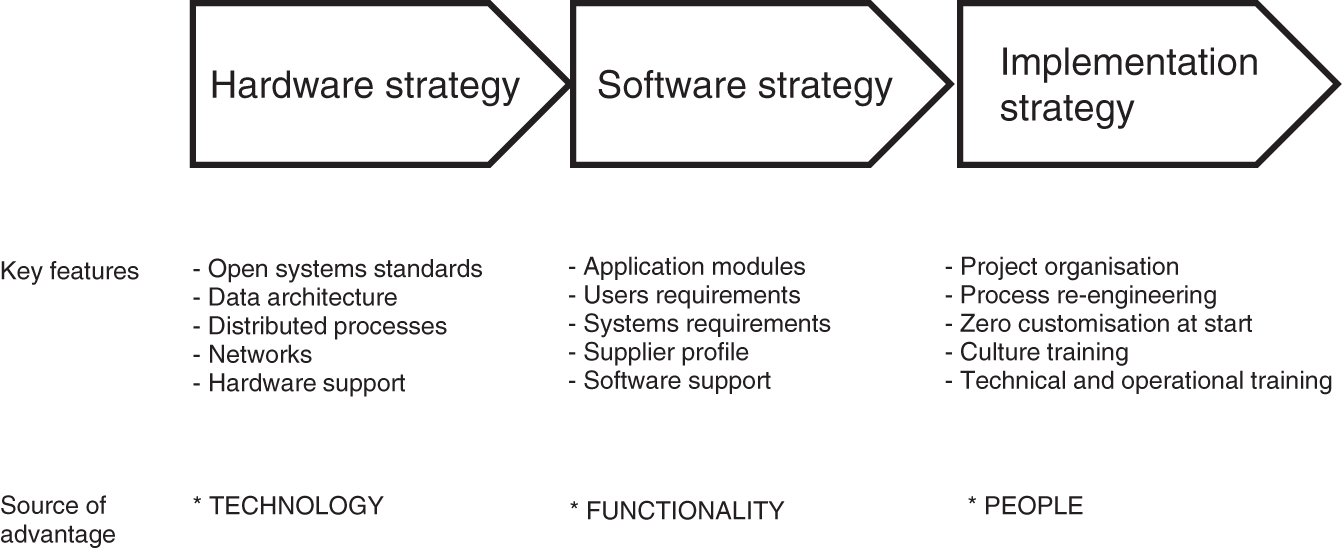
Figure 6.1 Information technology strategy
6.2.1. IT Hardware Strategy
Hardware requires auditing with a refresh cycle of ideally three years but no more than five years. Chief information officers (CIOs) have the ongoing challenge of possessing sufficient IT capability to respond to new business needs and balancing the cost of capital spending with operating efficiency, while at the same time they must be mindful of risk. The rapid growth in data storage has placed pressure on CIOs and has tempted them to retain old storage hardware. However, keeping older and not always reliable unsupported hardware can be costly and risky. Using hardware until it breaks down or the supporting application is no longer available might save capital expenditure in the short term but could prove disastrous over a longer period. Across a supply chain there will be significant differences in the way organisations run their operations and in the applications that are used. New hardware is quicker, consumes less power, requires less maintenance, is more reliable and reduces labour (help desks, fixing and maintenance). A well-managed refresh audit will ensure the correct tradeoffs between capital expenditure and lowering maintenance and power costs, as well as identifying actual and expected needs.
The hardware strategy should also include the capability of local hardware support both by suppliers and the company's own staff. The support capability may influence the selection of hardware. A sensible strategy is to go with the market leaders who are setting the de facto standards.
Enterprise Resource Planning (ERP) systems are supply chain IT systems that exchange information across all functions of an organisation or enterprise and can be extended across the supply chain to gain integration and the sharing of information. There are several modules of an ERP system that can be installed and are either standalone or function by interaction with other modules. Some of the key components are finance, purchasing, master production scheduling, materials management, sales and distribution, supplier management and human resources. ERP systems clearly hold major advantages over ‘legacy systems’ in terms of functionality, scope and flexibility of applications.
6.2.2. IT Software Strategy
At the early stage of information technology, applications software was limited to financial and commercial areas. Now a company is faced with a bewildering array of software ranging from design/process engineering, to manufacturing, to supply chain, to administration. Versions of specific software and systems technology will continue to change. Therefore, it is vital that a manufacturing company formulates a software strategy by careful planning.
The first step is to identify the areas of application depending on the size of activities and priorities of the company. Figure 6.2 shows a framework of application software in five key areas, namely financial administration, supply chain management, factory administration, and ‘client’ work station. The traditional computing modules of accounts and payroll are in the realm of financial management. The biggest area of application lies in supply chain management, starting from sales forecasting and ranging to customer service and electronic data interchange (EDI). At the factory shop floor there are two application areas, namely factory administration – comprising management information systems – and factory automation – encompassing design, process engineering and automation of equipment.
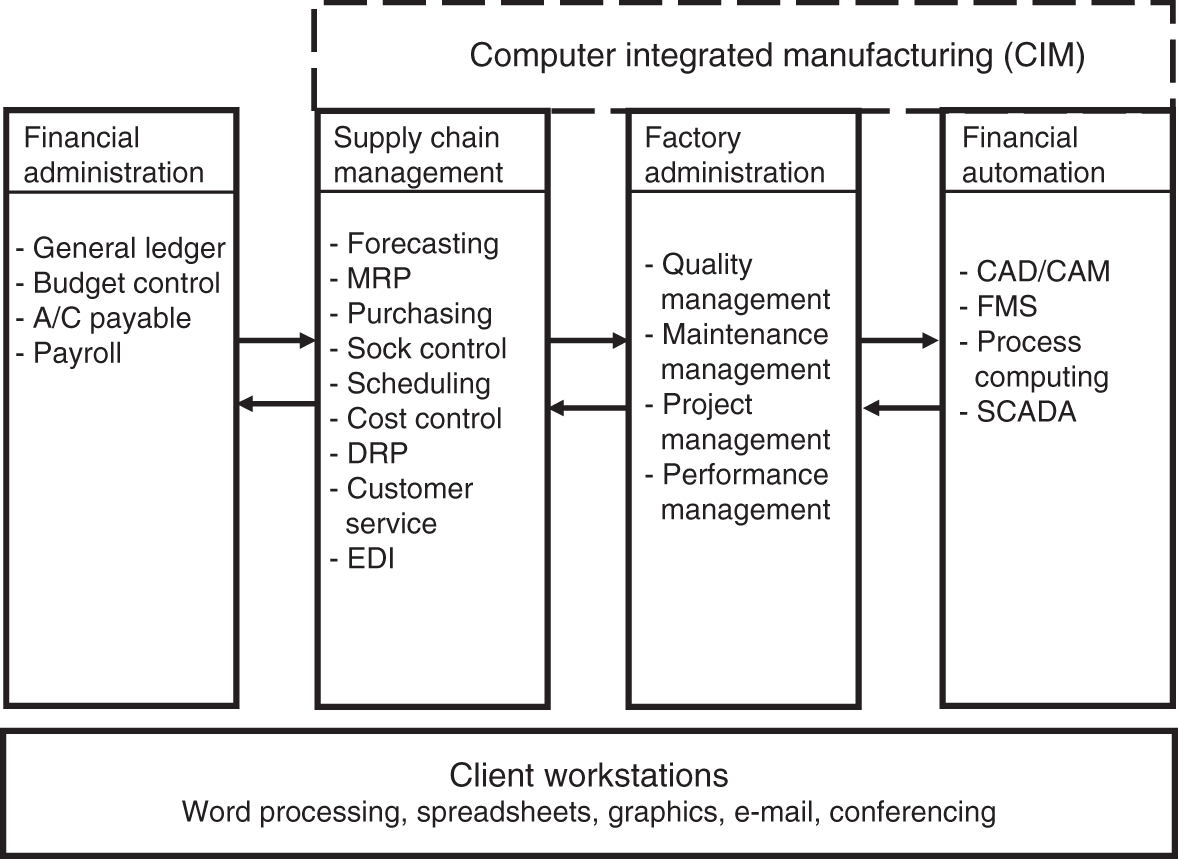
Figure 6.2 Application software modules
The software for client work stations is PC based. During the late 1980s many manufacturing companies searched for one turnkey package and invested in what is known as computer-integrated manufacturing (CIM), although with limited success. If a company follows an ‘open systems’ policy for a hardware and relational database then different proprietary software packages stand a better chance of being interfaced and database information can be shared in a client-server environment. Probably the most significant advantage lies in the enterprise-wise view of a business that ERP (Enterprise Resource Planning) systems allow.
The software policy should include standard packages for the company in specific areas of application. The selection of software should conform to the key criteria of user requirements, systems requirements, supplier profile and software support. The earlier examples of applications software were relatively inflexible and the approach was to ‘systematise the customer’ rather than ‘customise the system’. Many disillusioned customers attempted to build their own software and burnt their fingers in the process. In the present climate, software tools have become flexible, the IT technology is advancing rapidly and competitive expert support is provided by specialist software houses, and thus it is prudent to buy appropriate software rather than to develop your own (see Figure 6.3). The software should conform to open systems requirements and the supplier should be both reputable and locally available for support. The company should also build up its own IT support staff, especially a ‘user support’ service.
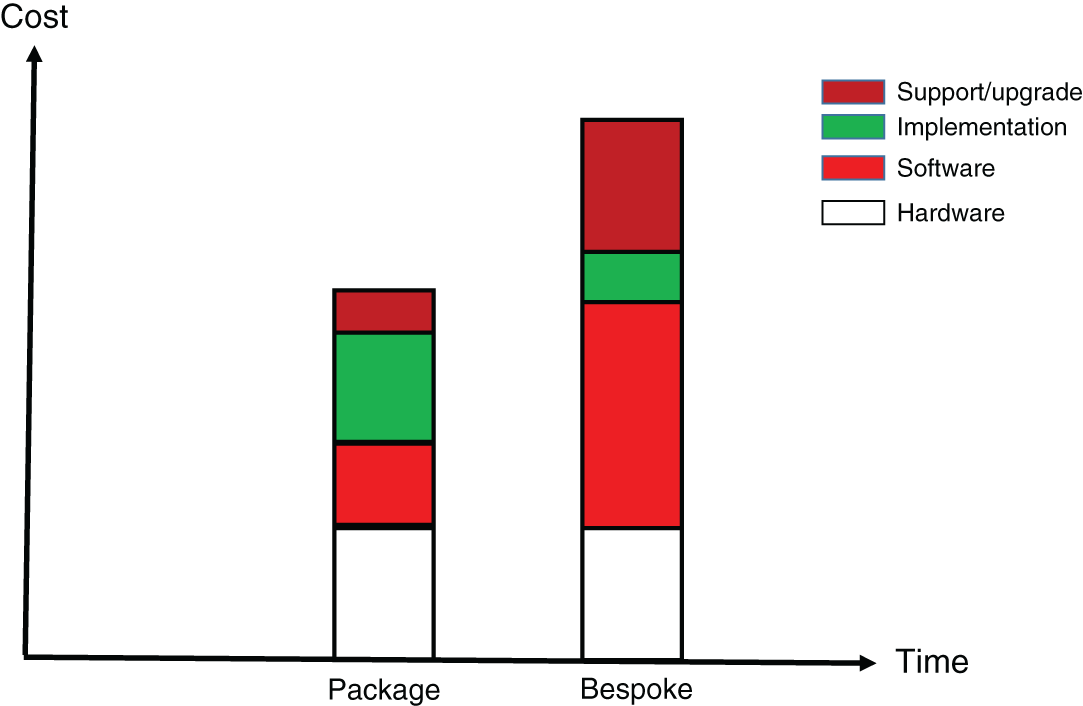
Figure 6.3 Software development strategy
There is a major conflict in developing a software strategy between a ‘best of breed’ approach and a ‘single integrator’ methodology. In a ‘best of breed’ methodology the optimum functionality solution of each individual function is chosen and companies attempt to integrate different types of systems. Although the business is likely to obtain the best solutions in each area, the problems of integration often offset the advantages of such top-quality solutions. ERP providers offer flexible modules that allow a single integrated framework of different functions of a supply chain stage. A single integrator approach also offers the advantage of technical support and a maintenance contract with a single source supplier.
6.2.3. Market Making Applications
There are broadly two types of market making applications. The first allows businesses to buy or sell by online auctions or bidding. Buyers place an open order to purchase an item and the sellers have the opportunity to bid. The second mechanism is the exchange or two-way auction platform containing a high-speed bid/ask bartering process.
6.2.4. Enterprise Resource Planning (ERP) Applications
Internet technology has certainly enhanced the collaborative business culture by enabling the transparency of online information and transactions. Company-centric enterprise application vendors, including SAP and Oracle (JD Edwards Enterprise One), have extended into supply chain supervision and customer relationship management.
6.2.5. Customer Relationships Management (CRM) Solutions
It is fair to state that most businesses regard the retention of customers as an important goal and therefore the criteria of CRM are not new or unfamiliar to most enterprises. However, the collaborative power of the Internet-based network has enhanced the need for customer intimacy and personalisation. A number of software solutions have been developed to provide some powerful holistic functionalities including:
- A customer database for knowing and understanding customer characteristics
- Managing the relationship with key business partners, (e.g. customers)
- Providing value-added services to retain customer loyalty
- Transparency and real-time acceptability of information for both customers and suppliers
- Optimising cross-selling opportunities
6.2.6. Supply Chain Management (SCM) Solutions
There are now few companies that do not recognise that the Internet has had a profound effect on supply chain performance. Applications that fall into this category are essentially decision support software packages for optimising multiple levels of demand and supply in the global supply chain.
The CPFR (Collaborative Planning Forecasting and Replenishment) for key stakeholders of the total supply chain has emerged. In CPFR, data and process model standards are developed for collaboration between suppliers and an enterprise with prescribed methods for planning (agreement between the trading partners to conduct business in a certain way), forecasting (agreed-to methods, technology and timing for sales, promotions and order forecasting) and replenishment (order generation and order fulfilment). These solutions take into account the constraints of transportation, supply capacity and inventory requirements. The ultimate objective is order fulfilment within the set time and at a cost acceptable to customers.
The early leading vendors in the market, e.g. i2 (now part of IBM) and Manugistics (acquired by JDA Software in 2006), have been surpassed by SAP and Oracle's JD Edwards Enterprise One.
6.2.7. Implementation Strategy
The success of an IT strategy depends on well-managed implementation as much as it does on the selection of the appropriate hardware and software.
Similar to a company-wide programme such as TQM, the implementation must have top management commitment. This should be reflected in setting up a project team comprising members from all users (marketing, logistics, manufacturing, accounts) and business systems. The project manager is usually chosen from the main user group. For example, if the application software is for supply chain management, then the project manager should ideally have a logistics background.
The project team should receive both technical training and operational coaching (functionality of the software). The project manager then prepares a clearly stated action plan with target dates and resources for key activities. This plan must include review points and steering by the members of the board.
It is essential that the existing procedures and processes are thoroughly and systematically reviewed. There are various tools for analysing the flow and requirements of these existing systems. Statistical Process Control (SPC) techniques are widely used. Nowadays some companies are applying computer-aided software engineering (CASE) tools to analyse the structure, database and flows of the existing processes and compare them with the proposed software for implementation. With the success of the Business Process Re-engineering (BPR) approach of Hammer and Champy (1993), some companies are utilising an IT application as a catalyst and applying the principles of BPR to re-engineer the total business processes of the company. The approach chosen should depend on the depth and breadth of the application systems, but there is no doubt that the existing procedures must be reviewed and refined when implementing a new method.
One important rule is that the user should not try to customise the system at the outset. Often, having acquired experience on the new system, the user may find that, in reality, the need for and nature of customisation could be very different. However, it is necessary that a ‘prototype’ is tested for any new system using the company's own data.
After the preparation and teaching of the project team, the training programmes should be extended to all potential users of the system. The training features should contain both cultural education to establish acceptance by everyone concerned and operational instruction to understand the functionality and operations of the new system. Training documents must be designed specifically for the users’ needs. The next stage is the data input and ‘dry run’ of the new system in parallel with the existing procedure before the system goes live. There are numerous benefits to forming user groups for exchanging experience, with members drawn both from within and from outside the company.
6.3. E-business
One might gain the impression from today's press that all business problems can be solved by e-business whilst, at the same time, the media do tend to blame all business failures and any economic downturn on e-business as well! Given the volume of news items on the subject, it may appear that defining ‘e-business’ is merely to state the obvious – or is it?
The distinctions between e-commerce, e-marketplace, and e-Business are poorly interpreted. For example, the most popular perception of e-business is that it is best exemplified by online shopping. However, it should be noted that in 2015 in the UK only 25% of retail sales were made online, rising to only 26.2% of sales in 2020, even taking into account the effect of Covid lockdowns (Coppola, 2021).
Let's take a moment to clarify some aspects. E-commerce is the transactional electronic exchange that takes place involving the buying and selling of goods and services.
The ‘e-marketplace’ is the online intermediary for electronic transactions between buyers, sellers and brokers. This is also referred to as the digital marketplace, portals, or hubs.
Early opportunities were observed in the enabling infrastructures and Internet-based networks (Internet, Intranet and Extranet), which replaced existing telephone, fax and EDI networks. The early success of e-procurement vendors (e.g. Commerce One, Ariba, Info Bank) was well received. However, the old suppliers suffered many problems including that of authorisation with no conformity of systems between business partners. It was rather like having different telephone systems for each of the people to whom you speak. This has been transformed by Trading Portals that interconnect the contents of different suppliers, thus making them usable by all buyers.
A report by Basu (2002) indicated that the complex web and infrastructure of e-business applications have been simplified, as shown in Figure 6.4 which illustrates the ‘building blocks’.
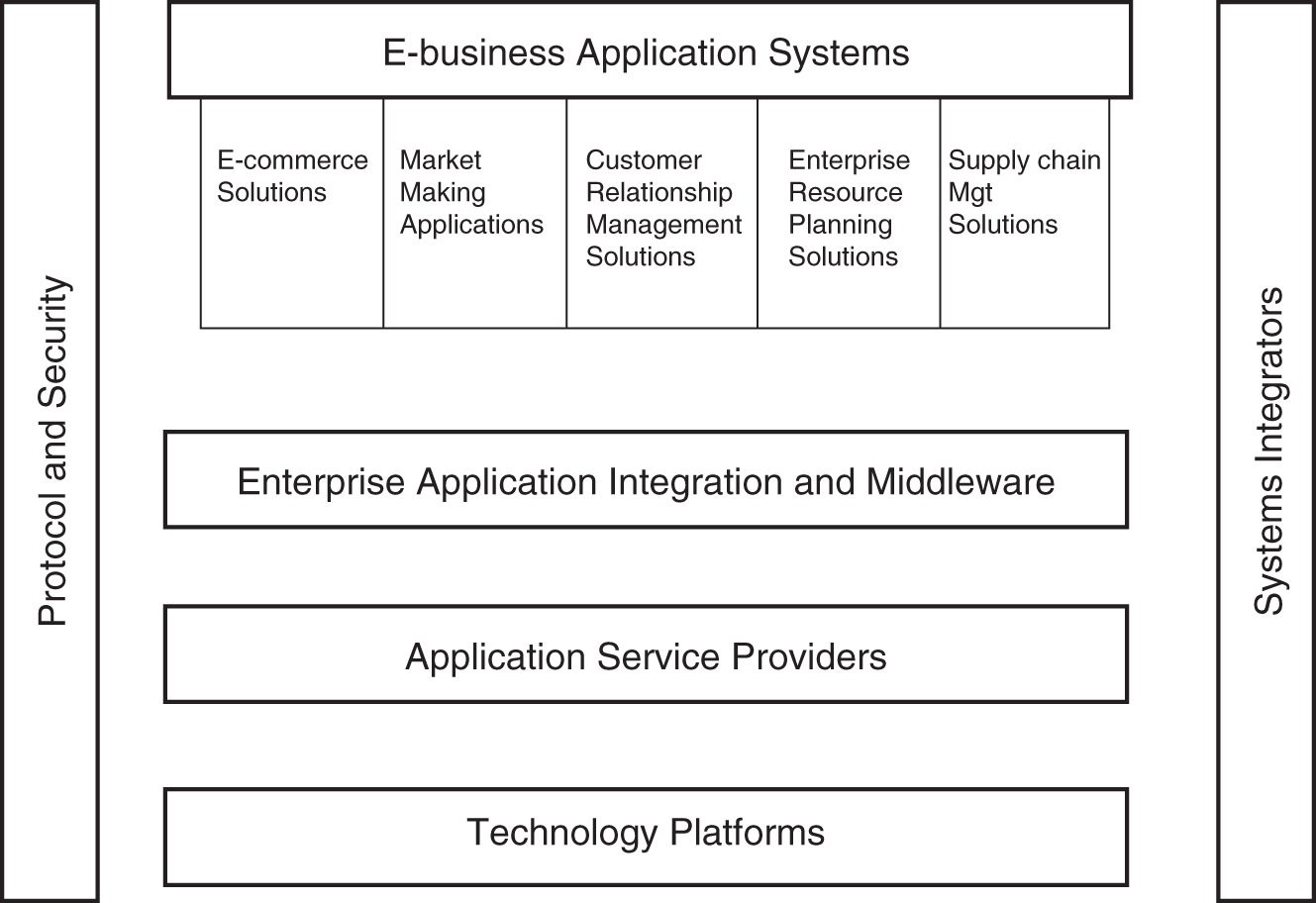
Figure 6.4 E-business building blocks
There are five key types of e-business application systems that enable businesses to trade and conduct electronic transactions or communications. These are:
- E-commerce solutions for both the ‘sell side’ and ‘buy side’ applications.
- Market making applications that enable multiple buyers and sellers to collaborate and trade.
- CRM solutions to facilitate improved business partnerships with customers.
- ERP solutions for site-based planning and execution of operations.
- SCM solutions for optimising the demand and supply in the total supply network including for the suppliers.
6.3.1. E-commerce Solutions
The buy-side applications of e-commerce, initially targeted at larger buyers, enable companies to levy across new or existing vendors. Solutions are increasingly aiming at integrating ERP systems with the organisation's own suppliers and customers. The new application developers are utilising the opportunities created by the lack of integration of ERP systems with other Internet systems and outside companies.
Initially, buy-side application vendors (including Commerce One and Ariba) were driven by pure-play solutions for the purchase of MRO (maintenance, repairs and operations) or indirect goods. The huge potential of e-procurement offered by ‘pure companies’ has been recognised and seized by established ERP vendors such as SAP and Oracle and software vendors like Netscape and Datastream.
The buy-side vendors, whether pure-play or not, are focussing on packaged buy-side application suites and looking to move into the direct procurement area. This requires a greater degree of understanding of business processes in specific industries and rigorous validation of the data processing.
The sell-side application vendors are looking to provide services content management and transaction processing. Hence, there are some sub-categories of software within this group. These include cataloguing, profiling, configurations and payment technologies. As a result, this sector is highly fragmented.
6.4. Big Data and Artificial Intelligence
The term ‘Big Data’ refers to piles of data that are meaningless unless you have the power to analyse them. Everyone has a limited vertical view of data sitting in its own silo. The advantage of Big Data is that it lets you get a 360 degree view of information in both vertical and horizontal planes and right across your organisation. Data from discrete silos is brought together by a single data lake in web services (such as AWS or Amazon Web Services), now commonly known as cloud computing.
A typical flow of Big Data Analytics is shown Figure 6.5, where unprocessed information from multiple sources is extracted into a daily batch of raw evidence. This data is then cleansed and brought into a data lake using cloud computing. The data is then transformed and queried by a set of web services tools (e.g. Apache) and then personalised and visualised by using Tableau.
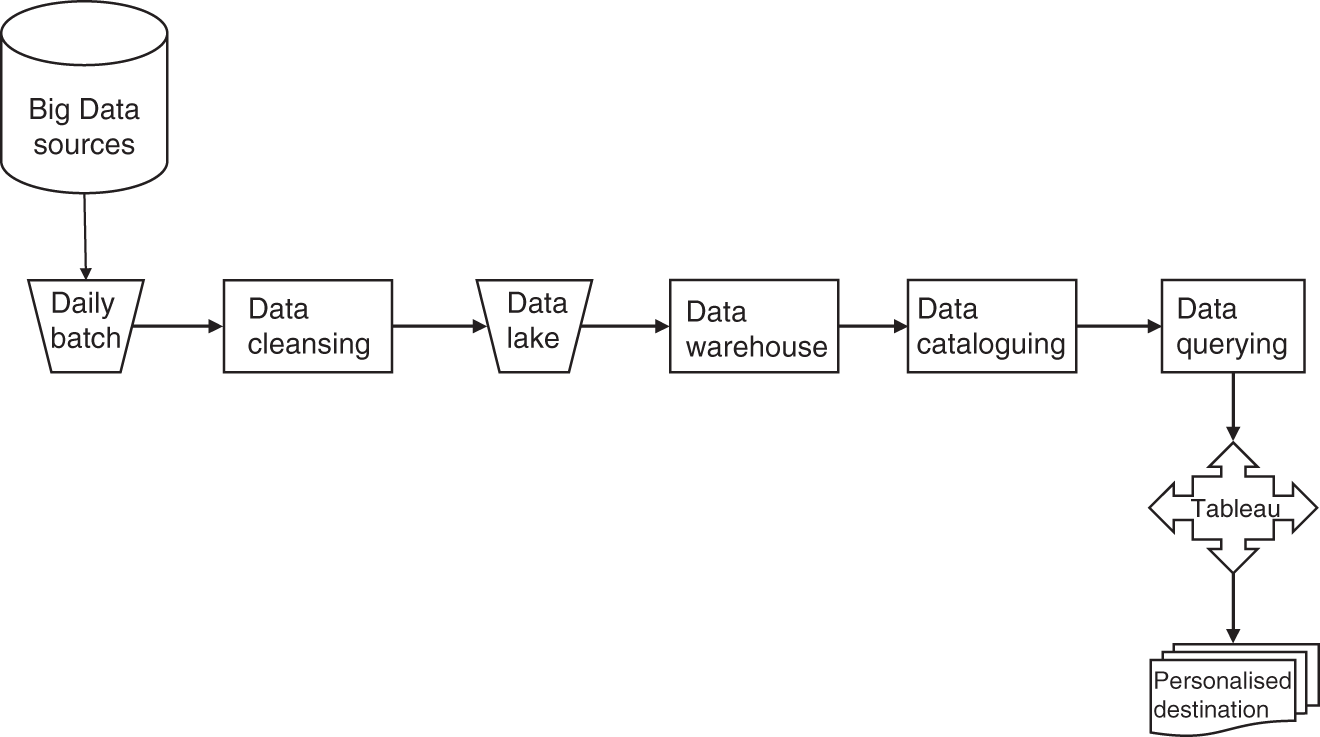
Figure 6.5 A typical flow of Big Data Analytics
One of the key benefits of cloud computing is the opportunity to replace up-front capital infrastructure expenses with low variable costs that scale with your business. Companies no longer need to plan for and procure servers and other IT infrastructure weeks or months in advance. As part of cloud computing, small and medium enterprises (SMEs) can afford to invest in licensed and expensive ERP systems (also called ‘on demand software’) on a so-called SaaS (Software as a Service) platform.
Artificial intelligence (AI) is the simulation of human intelligence processes by computer systems. AI research has been divided into sub-fields such as particular goals (e.g. ‘robotics’) and the use of specialised tools (‘machine learning’). Specific applications of AI include expert systems, natural language processing (NLP), speech recognition and machine vision.
AI programming concentrates upon three cognitive skills: learning, reasoning and self-correction. Learning processes of AI programming focus on acquiring data and creating rules or algorithms to provide computing devices with step-by-step instructions for how to complete a specific task. Machine learning (ML), a fundamental concept of AI research, is the study of computer algorithms that improve automatically through experience. Reasoning processes of programming focus on choosing the right algorithm to reach a desired outcome. Finally, self-correction processes of programming are designed to continually fine-tune algorithms and ensure they provide the most accurate results possible.
AI is relevant to any intellectual task and advanced robotics. Modern AI applications are too numerous to list here; however, some high-profile examples include autonomous vehicles (such as drones and self-driving cars), medical diagnosis, creating art (e.g. poetry), proving mathematical theorems, playing games (such as chess), search engines (for instance, Google Search), online assistants (such as Siri), image recognition in photographs, spam filtering, the prediction of judicial decisions and the forecasting of demands, to name a few.
Since the introduction of iPhone by Apple Inc. in June 2007, the iPhone iOS has dominated the mobile market, but Google Android has now demonstrably overtaken iPhone in terms of market share. In addition to the social media revolution, mobile technology and its ‘apps’ have encroached upon and indeed come to dominate our daily lives. Mobile and wireless devices are also enabling organisations to conduct business more effectively. Mobile applications can be used to support e-commerce with customers and suppliers, and to conduct e-business within and across organisational boundaries. There are two broad choices involved in deploying a system to mobile users, such as creating custom native apps targeted at major mobile platforms or developing a web application optimised for mobile access.
The Internet of Things (IoT) describes the network of physical objects connecting and exchanging data with other devices and systems over the Internet. IoT technology is generally related to smart homes including security devices and home appliances that can be controlled by smart phones. The IoT can also be used in industries and healthcare systems. There are, however, some concerns regarding IoT, especially in the areas of security and privacy.
A significant disruption in digital technology has been created by ‘blockchain technology’, which is popularly used as a generic term that most people associate with cryptocurrency (e.g. bitcoin). However, arguably it is more useful as distributed ledger technology, also known as ‘trustware’, because it replaces interpersonal trust with technological verification. This new form of technological trust can reduce the capacity of operators to behave opportunistically, enhance input verification and ensure transparency and traceability during transaction time.
6.5. Digital Tools for Green Six Sigma
Like pure-play Six Sigma, Green Six Sigma is also a data-driven process. Both the simpler tools (e.g. Histogram, Pareto Chart and Standard Deviation) and more complex instruments and techniques (e.g. ANOVA Report, Process Capability Analysis and Design of Experiment) require statistical analyses. There are many software systems available for such statistical evaluations, the most commonly used of which are Minitab and SPSS.
Minitab (Minitab.com) is a statistics package developed at Pennsylvania State University and distributed by Minitab LLC. This powerful statistical analysis package is a favourite with Six Sigma practitioners and offers three areas of functions – Discover, Predict and Achieve. Minitab can empower all parts of an organisation to predict better outcomes, design enhanced products and improve processes. It can access modern data analysis and explore data even further with advanced analytics and open source integration. Visualisations can help present the findings through scatterplots, bubble plots, histograms, parallel plots, time series plots and more.
The many areas of Minitab output include:
Graphics
- Scatterplots, boxplots, histograms, time series plots
Basic Statistics
- Descriptive statistics
- Correlation and covariance
- Normality test
- Linear regression
- Nonlinear regression
- Partial least squares
- Orthogonal regression
- Poisson regression
- Plots: residual, factorial, contour, surface, etc.
Analysis of Variance
- ANOVA
- MANOVA
- Test for equal variances
- Analysis of means
Quality Tools
- Run chart
- Pareto chart
- Cause and effect diagram
- Process capability
- Variability chart
Design of Experiments
- Definitive screening designs
- General factorial designs
- Response surface designs
- Taguchi designs
- User-specified designs
- Response prediction and optimisation
Another type of software package is SPSS (Pallant, 2010) which is used for interactive, or batched, statistical analysis. It has been produced by SPSS Inc. for some years and was acquired by IBM in 2009. The initial Version 1 appeared in 1968 and SPSS has now reached Version 26. The package has run on MS Windows since Version 16. Like Minitab, SPSS is a powerful data analysis package that can handle complex statistical processes. It is assumed that the user is versed in the fundamentals of statistics; in fact, instruction in statistics and the use of Minitab and SPSS constitute a vital part of Black Belt training.
SPSS tools and techniques for statistical data analyses include:
Descriptive Statistics
- Histogram and assessing normality
- Checking outliers
- Bar chart and line chart
- Scatter diagram
- Box plot
Statistical Techniques
- Regression analysis
- Correlation analysis
- Factor analysis
- T-tests
- ANOVA
- MANOVA
- Analysis of co-variance
6.6. Digital Technology Applications in Climate Change
Various approaches and tools are currently being tried and advocated regarding how best to tackle climate change and sustainable development and the creation of ecological value. To this, digital sustainability activities can be added that focus on digital innovations to create scalable socioecological value. The technologies most commonly used in such digital sustainability tasks include distributed ledger technologies (blockchain), artificial intelligence and machine learning, Big Data Analytics, mobile technology and applications, sensors and other IOT devices, and additional tools like satellites and drones.
George et al. (2020) explore the opportunities and challenges of digital technology in climate change initiatives and define them as ‘digital sustainability activities’. The authors give credit to entrepreneurial organisations who have adopted innovative approaches to ecological challenges and support them with examples including the following:
- Poseidon, a Malta-based foundation, is tokenising carbon credits by blockchain tokens from conservation programs in the Andean rainforest. It changes or tokenises those credits into ‘carbon by the gram’.
- Ecosia is a search engine that uses 80% of its advert revenue to plant trees to fight global warming. Ecosia enables users to contribute to tree planting by simply installing Ecosia as their default search engine.
- Efforce is a blockchain-based energy-saving trading platform seeking to revolutionise the market for Energy Performance Contracting (EPC) to achieve infrastructure upgrades that reduce energy costs. An energy service company (ESCO) proposes improvements to an industrial facility, which are then funded by a finance partner.
- At the supply stage, Olam, an agribusiness multinational based in Singapore, is working to digitise the origination process for crops like cocoa across its global network. By equipping small-scale farmers with mobile phones armed with a digital sales platform, Olam cuts out price-setting middlemen and provides higher prices to farmers.
There are many proven software tools already available in the market to measure and monitor carbon footprint of business operations (e.g. evizi, Emitwise, GaBi and more). These digital tools are providing practical help in climate change initiatives.
6.7. Summary
When looking at information technology I have taken a more general approach. This section is equally applicable to all functions of the organisation involved in climate change initiatives. The key issue in any new IT system is knowing what you want, going with a system that has local support and initially making do with off-the-shelf software.
I have not discussed topics such as uninterrupted power supply, disaster recovery, the need to back up files and so on. All these issues are ‘nuts and bolts’ and should be second nature to your IT manager. This section was not written for the professional IT executive, but rather to give the average manager an understanding of the strategy of IT implementation. I have also addressed the opportunities and challenges emerging from e-business technologies, Big Data Analytics, Artificial Intelligence, mobile technology, IoT and blockchain technology.
During the last ten years we have experienced the growth of e-business applications and enabling infrastructures that have rapidly increased productivity by streamlining existing business processes. The time has come to take a fresh look at Internet technology, cloud computing and Artificial Intelligence. We need to see such digital technology as a powerful enabling tool that can be used in almost any business and become part of almost any strategy. The key question now is not whether to implement digital technology, but how to deploy it.
The proactive and ambitious international and national plans and support for meeting the challenge of the Paris Climate Agreement cannot be doubted, along with their laudable ambition to achieve net-zero carbon emissions by 2050. However, the challenge is to make it happen at the sources of emissions including power plants, factories, infrastructures, transport systems and buildings. Both sustainable digital activities and Green Six Sigma tools and techniques, underpinned by its holistic approach, can be vital factors in such implementation programmes.
